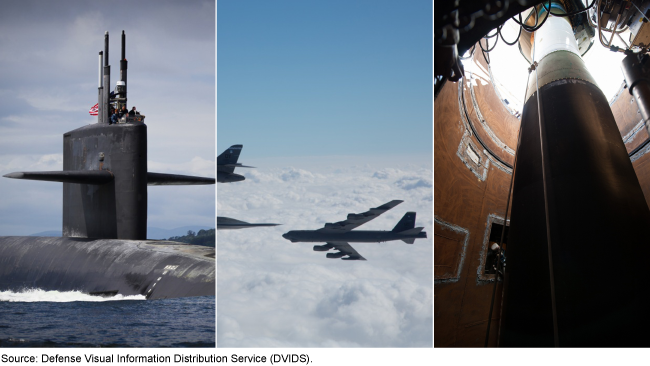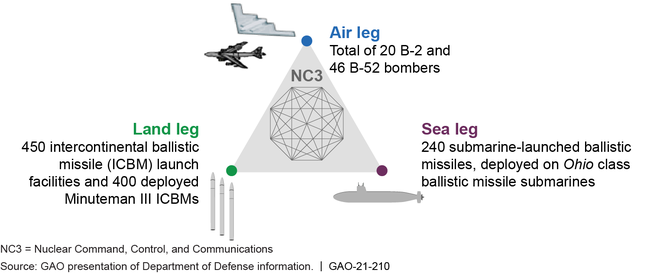Nuclear Triad: DOD and DOE Face Challenges Mitigating Risks to U.S. Deterrence Efforts
Fast Facts
Three kinds of systems that can launch nuclear weapons make up the U.S. nuclear triad:
- Nuclear-capable heavy bombers (known as the "air leg")
- Intercontinental ballistic missiles or ICBMs ("ground leg")
- Ballistic missile submarines ("sea leg")
Most of these systems, however, are nearing or past their planned end-of-life dates. And all of their replacement systems are at risk of delays. For example, parts of the current ICBM could age out faster than expected, while the replacement ICBM faces delays.
The Departments of Defense and Energy must carefully manage their nuclear weapons programs to continue to credibly deter foreign adversaries.
The three legs of the U.S. nuclear triad: sea, air, and land

Highlights
What GAO Found
The Department of Defense (DOD) plans to replace or modernize existing triad platforms including submarines, intercontinental ballistic missiles, and bomber aircraft, as well as many of the nuclear command, control, and communication systems that facilitate control of them (see below). The Department of Energy (DOE) plans to modernize its nuclear infrastructure to life extend and produce warheads and bombs. DOD will be challenged to meet some U.S. Strategic Command (USSTRATCOM) operational needs with existing triad systems, shown below, through the end of their service lives. DOD must manage shortfalls in quantities of systems that it can field and capability limitations that reduce effectiveness of these systems. For example, the Navy will have to carefully manage resources to meet USSTRATCOM's operational requirements for the Ohio class submarine. Further, DOE faces a long-term sustainment challenge with one of its bombs, the B83-1.
Existing Nuclear Triad Platforms

DOD and DOE are working to replace triad systems nearing retirement, but these replacement programs face schedule risks that could exacerbate challenges with existing triad systems. Replacement programs have risk factors that include concurrency between phases of acquisition programs from development through production, immature technologies, and limited schedule margin. For example,
- The Ground Based Strategic Deterrent program includes limited schedule margin for testing, and if it fails a major test event it would likely delay initial fielding.
- The schedules for DOE's life extension programs are highly dependent on the availability of suitable facilities to manufacture, assemble, and assess bomb and warhead components. However, many DOE facilities needed for these efforts are outdated or obsolete, as more than half of DOE's facilities are over 40 years old.
DOD and DOE have limited ability to mitigate risks to the efficacy of the nuclear deterrent with their current strategy, and are beginning to consider alternatives.
Why GAO Did This Study
The 2018 Nuclear Posture Review indicates that DOD's highest priority is the nuclear deterrent, made up of sea, land, and air legs—referred to as the nuclear triad. DOD has reported that due to prior delays and challenges with aging nuclear triad systems, there is little to no margin for delaying replacement systems without incurring risk to the nuclear deterrent. Similarly, DOE faces a demanding schedule for infrastructure projects and programs for the life extension and production of warheads and bombs.
In this report, GAO examines (1) the challenges DOD and DOE face in meeting operational needs with existing triad systems; (2) the extent to which DOD and DOE triad acquisition programs face schedule risks, and the implications of delays; and (3) whether DOD and DOE have strategies to mitigate risks to the nuclear deterrent, including acquisition delays. To do this work, GAO analyzed DOD and DOE documentation, interviewed officials, and leveraged GAO work on acquisition best practices, triad systems, and the nuclear enterprise.
This is an unclassified version of a classified report we issued in June 2020, and specific classified information has been removed.
Recommendations
GAO is not making any recommendations because DOD and DOE have ongoing analyses related to a number of potential nuclear triad risk mitigation approaches. However, GAO has made recommendations in prior reports related to triad programs.
